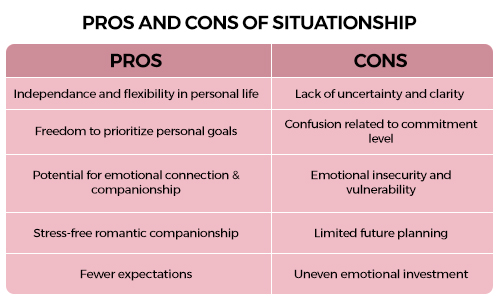Have you ever been in a situation where you saw someone but weren’t in a relationship? If so, you and your partner might have had fun together without discussing plans. You could be in a situationship, which involves no formal commitment. Learn more about what a situationship is, including its signs, pros, and cons.
What Is a Situationship?
A situationship can be described as an undefined romantic relationship with no clear boundaries or commitment. It often arises from short-term circumstances or convenience, where individuals spend time together but avoid discussing or planning for the future. Essentially, It provides the benefits of a relationship without formal commitment, allowing individuals to enjoy companionship while keeping things flexible.
Signs of Situationship

Now, you understand what is situationship. Let’s get familiar with other signs that point to this.
1. No Growth
In this relationship, you will not talk about long-term commitment plans. You will make sure the relationship works well currently without thinking about the future. A situationship is lighthearted. However, you will make a slow and wise move if you are planning a different kind of relationship, which requires more commitment and desire.
2. Romantic Involvement With Others
You may be in a situationship where your partner is romantically involved with one or more people. All parties should stay informed about the relationship and have clear boundaries.
3. Short-Term Plans
Those in serious relationships have weekly, monthly, and yearly plans. However, people in this kind of relationship mostly see during odd hours or out of the blue. They don’t have any specific plans.
4. Lack of Integration
You have never met their friends and parents. And neither of you might interact with each other very often. For example, in a situation relationship, your partner may or may not know about your whereabouts.
If your connection exists in an emptiness, it could be a situationship.
5. Often Make Excuses
When you are in a relationship, you make time for your partner no matter what. In situations like this, it sounds like ‘I’m traveling’, ‘Work’s busy’, and ‘I need to hit the gym.’ You are allowed to make excuses and the other partner cannot expect an explanation for all excuses you make.
6. Not Much Serious
The opposite person tells you that they don’t want to get serious. They will show you what they think through their actions.
Pros and Cons of Situationship
There are a lot of positives and negatives in a situationship, even if it’s mutual. Here are some pros and cons you must be aware of.

Real-Life Examples of Activities and Scenarios that Characterize Situationship
1. Causal Dates
You and your partner might enjoy each other’s company, but you don’t see yourself in the future.
2. Frequent Hangouts
You may spend a lot of time together without expecting anything in the future.
3. Intimacy
Physical intimacy is a part of your conversation, but officially, you are not a couple.
4. Last-Minute Plans
Most of your meetings are unplanned and unscheduled, as there are no commitments.
5. Social Media Follows
You might follow each other on social media without defining your relationship status to others (even the close ones)
6. Companionship
You might attend special occasions and Christmas parties and even go on holiday together without a clear discussion about the relationship.
7. Uncertain Communication
You enjoy the company of your partner, but there isn’t a committed relationship.
How to Heal From Unhealthy Situationship?

It is not a real or long-distance relationship; however, the people in it are real. Healing from this is harder than going through a breakup. The lack of clarity makes them painful and confusing. Have you faced difficulty healing from a situationship? No more worries! We will help you with some suggestions to get over this.
- Create emotional and physical distance from the person involved in the situationship.
- Kind to be yourself and try to be patient.
- Focus on self-care activities such as gardening, reading, painting, and more.
- Think about what aligns with your needs and values in a relationship.
- Create clear boundaries based on your comfort level.
- Spend quality time with friends and family.
- Seek professional help such as counseling and therapy when you need it.
Lack of clarity in a situationship often leads to uncertainty and confusion. Identifying the potential signs and its negative effects on your mental health is important. Consider entering healthier relationships, setting boundaries, and seeking support.
FAQ:
1. What are the signs of a situationship?
Signs of a situationship include unclear commitment, inconsistent communication, no defined labels or future plans, frequent ambiguity about the relationship, and emotional uncertainty.
2. What are the rules of a situationship?
In a situationship, rules typically involve avoiding labels or commitments, keeping communication casual, not planning for the future, and staying emotionally flexible.
3. Does situationship mean single?
A situationship doesn’t always equate to being single, but it typically means there’s no clear commitment or formal relationship status. It involves involvement without defined labels.
4. At what point is it a situationship?
A relationship is considered a situationship when it lacks clear commitment, defined labels, or future plans. It involves emotional involvement without a formal relationship status.
5. Is situationship a hookup?
A situationship isn’t just a hookup. While it can include casual encounters, it generally involves emotional involvement and ambiguity about the relationship’s status and future.
Linda
Related posts
Women Tips
Privacy Overview
| Cookie | Duration | Description |
|---|---|---|
| cookielawinfo-checkbox-analytics | 11 months | This cookie is set by GDPR Cookie Consent plugin. The cookie is used to store the user consent for the cookies in the category "Analytics". |
| cookielawinfo-checkbox-functional | 11 months | The cookie is set by GDPR cookie consent to record the user consent for the cookies in the category "Functional". |
| cookielawinfo-checkbox-necessary | 11 months | This cookie is set by GDPR Cookie Consent plugin. The cookies is used to store the user consent for the cookies in the category "Necessary". |
| cookielawinfo-checkbox-others | 11 months | This cookie is set by GDPR Cookie Consent plugin. The cookie is used to store the user consent for the cookies in the category "Other. |
| cookielawinfo-checkbox-performance | 11 months | This cookie is set by GDPR Cookie Consent plugin. The cookie is used to store the user consent for the cookies in the category "Performance". |
| viewed_cookie_policy | 11 months | The cookie is set by the GDPR Cookie Consent plugin and is used to store whether or not user has consented to the use of cookies. It does not store any personal data. |

